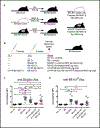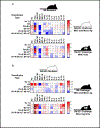Allogeneic major histocompatibility complex antigens are necessary and sufficient for partial tolerance induced by transfusion of pathogen reduced platelets in mice
- PMID: 30734299
- PMCID: PMC6465144
- DOI: 10.1111/vox.12756
Allogeneic major histocompatibility complex antigens are necessary and sufficient for partial tolerance induced by transfusion of pathogen reduced platelets in mice
Abstract
Background and objectives: Alloimmunization is common following transfusion with platelet-rich plasma (PRP) and can cause complications such as platelet refractoriness or transplant rejection. It has previously been shown that pathogen reduction of PRP with riboflavin and UV light (UV+R) can protect against alloimmunization in mice and induce partial tolerance to subsequent transfusions.
Materials and methods: Using B6 H2d congenic mice, this study evaluated the relative contributions of major histocompatibility complex (MHC) antigens and minor antigens to both the alloresponse to PRP transfusion and the partial tolerance induced by UV+R treatment.
Results: Both total and MHC-specific alloantibody responses were highest when both MHC and minor antigens were mismatched, with lower alloantibody responses observed with MHC mismatch alone, demonstrating that allogeneic minor antigens can enhance the response to allogeneic MHC. There was a weak, but significant alloantibody response to minor antigens only. UV+R treatment protected against both major and minor antigen alloimmunization. Both allogeneic MHC and minor antigens primed an enhanced cytokine response ex vivo, though this was weaker with minor antigens, and both responses were blocked with UV+R treatment.
Conclusion: Allogeneic MHC is both necessary and sufficient to induce the partial tolerance associated with UV+R treatment.
Keywords: alloimmunization; major histocompatibility complex; minor antigens; pathogen reduction; tolerance.
© 2019 International Society of Blood Transfusion.
Figures





References
-
- Howard JE, Perkins HA: The natural history of alloimmunization to platelets. Transfusion 1978; 18: 496–503. - PubMed
-
- Itescu S, Tung TC, Burke EM, et al.: Preformed IgG antibodies against major histocompatibility complex class II antigens are major risk factors for high-grade cellular rejection in recipients of heart transplantation. Circulation 1998; 98: 786–93. - PubMed
-
- Andreu G, Dewailly J, Leberre C, et al.: Prevention of HLA immunization with leukocyte-poor packed red cells and platelet concentrates obtained by filtration. Blood 1988; 72: 964–9. - PubMed
-
- Dutcher JP, Schiffer CA, Aisner J, et al.: Alloimmunization following platelet transfusion: the absence of a dose-response relationship. Blood 1981; 57: 395–8. - PubMed
MeSH terms
Substances
Grants and funding
LinkOut - more resources
Full Text Sources
Research Materials

